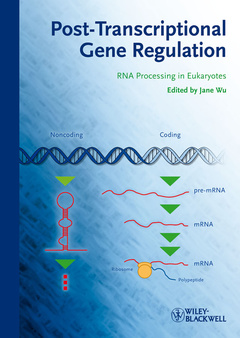Post-Transcriptional Gene Regulation RNA Processing in Eukaryotes
Coordonnateur : Wu Jane

Foreword XI
List of Contributors XIII
1 The Role of Cotranscriptional Recruitment of RNA-Binding Proteins in the Maintenance of Genomic Stability 1
Jennifer A. Aoki and James L. Manley
1.1 Introduction 1
1.2 THO/TREX 2
1.3 Linking Transcription to Export of mRNP 4
1.4 Cotranscriptional R-loop Formation 7
1.5 R-loop-induced Double-Stranded (ds) DNA Breaks 10
1.6 Concluding Remarks 12
References 12
2 Transcription Termination by RNA Polymerase II 19
Minkyu Kim and Stephen Buratowski
2.1 Messenger RNA Gene Termination 19
2.2 Small Nucleolar RNA Gene Termination Pathway 23
2.3 Choice between the Two Termination Pathways 25
2.4 Regulation of Transcription by Termination 27
2.5 Mechanisms of Termination by Other RNA Polymerases 30
2.6 Future Perspectives 31
Acknowledgments 32
References 32
3 Posttranscriptional Gene Regulation by an Editor: ADAR and its Role in RNA Editing 41
Louis Valente, Yukio Kawahara, Boris Zinshteyn, Hisashi Iizasa, and Kazuko Nishikura
3.1 Introduction 41
3.2 The RNA Editing Kinship 44
3.3 The ADAR Gene Family 45
3.4 The Role of RNA in the A-to-I Editing Mechanism 51
3.5 Splice Site Alterations 52
3.6 A-to-I RNA Recoding Modifies Proteins Such As Neurotransmitters 55
3.7 Cellular Effects and in Vivo Phenotypes of ADAR Gene Inactivation 59
3.8 Noncoding RNA and Repetitive Sequences 61
3.9 Effects on the RNA Interference Silencing Pathway 64
3.10 Effects on MicroRNA Processing and Target Selection 66
3.11 RNA Editing Role as an Antiviral Mechanism 67
3.12 Conclusions 68
Acknowledgments 69
References 69
4 Posttranslational Modification of Sm Proteins: Diverse Roles in snRNP Assembly and Germ Line Specification 83
Graydon B. Gonsalvez and A. Gregory Matera
4.1 Introduction 83
4.2 Protein Methylation – Flavors and Functions 84
4.3 Sm Proteins Contain sDMA- and aDMA-Modifi ed Arginines 86
4.4 SnRNP Assembly, the Survival Motor Neuron (SMN) Complex, and Spinal Muscular Atrophy (SMA) 87
4.5 PRMT5 and PRMT7 – The Sm Protein Methyltransferases 89
4.6 Sm Protein Methylation is Required for sn/RNP Assembly in Mammals 92
4.7 Sm Protein Methylation in Drosophila 94
4.8 Unresolved Questions: Sm Protein Methylation and snRNP Assembly 95
4.9 Conclusion – The Evolution of snRNP Assembly 96
4.10 Sm Proteins Are Required for Germ Cell Specification 97
4.11 Dart5, Valois, Sm Proteins, and Tudor Anchoring 100
4.12 Unresolved Questions: Sm Proteins and Germ Cell Specification 101
4.13 The Transcriptional Functions of PRMT5 102
4.14 Arginine Methylation – No Longer in the Shadow of Phosphorylation 103
4.15 Sm Proteins – Doughnut-Shaped Relics of Our RNA Past 104
References 106
5 Structure, Function, and Biogenesis of Small Nucleolar Ribonucleoprotein Particles 117
Katherine S. Godin and Gabriele Varani
5.1 Introduction 117
5.2 The Guide RNA 119
5.3 The Core sno/sRNP Proteins 120
5.4 Assembly and Structural Organization of sno/sRNPs 122
5.5 Asymmetric Assembly, Structure, and Activity of the Box C/D 122
5.6 The Box H/ACA RNP Structure and Assembly of the Eukaryotic RNP 125
5.7 Summary 128
References 128
6 Mechanistic Insights into Mammalian Pre-mRNA Splicing 133
Sebastian M. Fica, Eliza C. Small, Melissa Mefford, and Jonathan P. Staley
6.1 Introduction 133
6.2 Chemistry of Splicing 133
6.3 Composition and Assembly of the Spliceosome 135
6.4 Control of Spliceosome Assembly and Activation 139
6.5 Spliceosome Structure and Dynamics 141
6.6 The Structure of the Spliceosomal Active Site and the Mechanism of Catalysis 145
6.7 Fidelity in Splicing 149
6.8 Concluding Remarks 151
Acknowledgments 152
References 152
7 Splicing Decisions Shape Neuronal Protein Function across the Transcriptome 163
Jill A. Dembowski and Paula J. Grabowski
7.1 Introduction 163
7.2 A Diversity of RNA-Binding Protein Regulators 165
7.3 Gene-Specific and Global Experimental Approaches to Splicing Mechanisms 167
7.4 Alternative Splicing of Dscam Pre-mRNA: Mechanism and Significance for the Development of Neuronal Circuits 169
7.5 The NMDA R1 Receptor: Brain-Region-Specific and Activity-Dependent Splicing 171
7.6 Alternative Splicing Response to Neuronal Excitation 172
7.7 Splicing Silencing by PTB: Versatility of Mechanism and Cross-Regulation of nPTB 173
7.8 Upstream Regulation of Splicing Factors by MicroRNAs 175
7.9 Conclusions and Prospects 176
Acknowledgments 177
References 177
8 Noncoding RNA: The Major Output of Gene Expression 181
Matthias Harbers and Piero Carninci
8.1 Introduction 181
8.2 What is ncRNA? 182
8.3 Discovery of ncRNAs 182
8.4 ncRNA Families 190
8.5 Examples for ncRNA Functions 196
8.6 Perspectives 200
8.7 Note Added in Proof 202
Acknowledgments 202
References 203
9 Noncoding RNAs, Neurodevelopment, and Neurodegeneration 215
Mengmeng Chen, Jianwen Deng, Mengxue Yang, Kun Zhu, Jianghong Liu, Li Zhu, and Jane Y. Wu
9.1 Introduction 215
9.2 Expression of ncRNAs in the Nervous System 215
9.3 ncRNAs in Neurodevelopment 218
9.4 ncRNAs in Neurodevelopmental and Neuropsychiatric Diseases 219
9.4.1 MicroRNAs and Neurodevelopmental Disorders 220
9.5 ncRNAs in Neurodegeneration 224
9.6 Concluding Remarks and Perspectives 227
Acknowledgments 228
References 228
Further Reading 236
10 The Evolution of the Modern RNA World 239
Ying Chen, Hongzheng Dai, and Manyuan Long
10.1 Evolution of Noncoding RNA Gene 239
10.2 Evolution of Transcriptional Regulation 242
10.3 Evolution of Posttranscriptional Gene Regulation 243
10.4 Phenotypic Evolution by the Origination of New ncRNA Genes and Perspectives between Protein-Coding and ncRNA Genes 247
References 249
Index 253
Date de parution : 08-2013
Ouvrage de 280 p.
17.7x24.8 cm
Disponible chez l'éditeur (délai d'approvisionnement : 14 jours).
Prix indicatif 125,33 €
Ajouter au panierThème de Post-Transcriptional Gene Regulation :
Mots-clés :
Post-Transcriptional Gene Regulation, Jane Wu, Transcription and Splicing, Histone RNA Processing, SnRNP Biogenesis/Protein Arginine Methylation, Pre-mRNA Splicing and Catalytic Mechanisms, Visualization and Manipulation of Alternative Splicing in Vivo, Splicing Regulation and Diseases, RNA Interference, Evolution of Non-protein Coding RNA Genes, miRNA, RNA modifications
